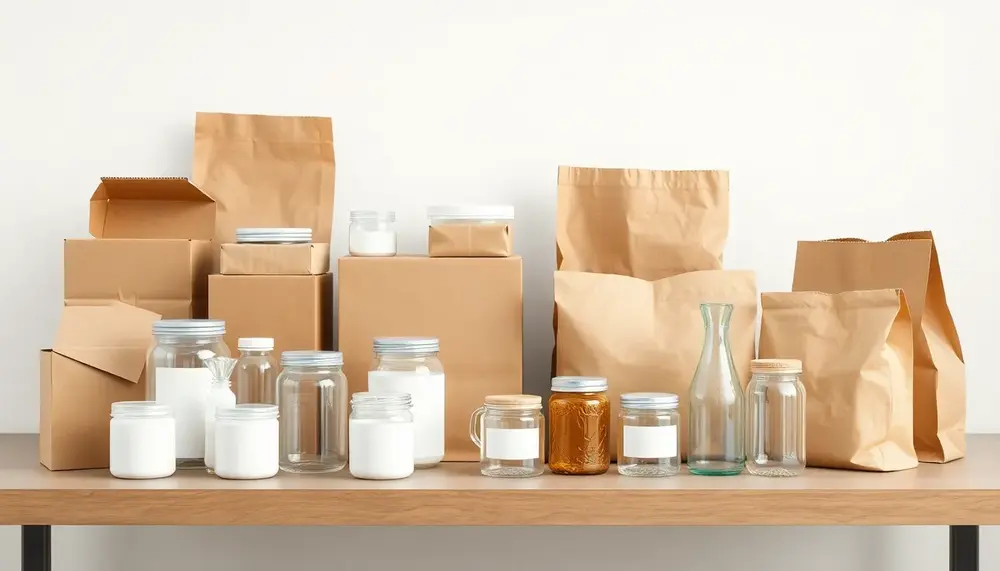Table of Contents:
Choosing the Right Structure for a Packaging Materials Slideshare
Crafting a Slideshare about packaging materials is not just about stacking facts on slides. The real art lies in structuring your content so that it flows logically, answers the burning questions of your audience, and visually guides them from curiosity to actionable knowledge. What works? Well, a clear narrative arc—think of it as a story with a beginning, middle, and end—will make your Slideshare stand out from the sea of generic presentations.
Start with a compelling hook: Pose a problem or surprising fact about packaging losses or innovation. This instantly signals relevance and grabs attention. Next, outline the scope—are you focusing on food, pharma, or industrial packaging? Being specific helps your viewers orient themselves.
Segment your content with purpose:
- Material Profiles: Dedicate a section to each key material (glass, metal, plastics, paper, composites), but don’t just list properties. Instead, show where each shines and where it falls short, using real-world scenarios or data.
- Comparative Analysis: Insert a slide or two with direct, side-by-side comparisons. Use simple tables or infographics to highlight differences in barrier properties, cost, or sustainability.
- Visual Demonstrations: Whenever possible, integrate photos, diagrams, or even short video clips to show materials in action—think damaged produce, pristine pharma vials, or eco-friendly cartons.
- Case Studies or Spotlights: Short, punchy examples of packaging success or failure can make abstract material choices tangible.
End with actionable insights: Don’t just summarize—give your audience a clear takeaway. For example, a decision matrix or checklist for choosing materials based on product type, shelf life, or regulatory needs. This transforms your Slideshare from a passive info-dump into a practical toolkit.
Ultimately, the right structure is the backbone of a Slideshare that not only informs but actually empowers your viewers to make smarter packaging decisions. And isn’t that the whole point?
Key Packaging Material Types: Strengths, Weaknesses, and Best Uses
When it comes to packaging materials, not all options are created equal. Each type brings its own set of advantages and drawbacks, making the selection process a bit of a balancing act. Here’s a focused look at key material types, what they excel at, where they stumble, and when you’d actually want to use them.
- Glass: Strengths: Absolute barrier to gases and moisture, inert, and highly recyclable. Weaknesses: Heavy, breakable, and energy-intensive to produce. Best Uses: Premium foods, beverages, and pharmaceuticals where product purity and shelf life are critical.
- Metals (Aluminum, Tinplate): Strengths: Exceptional protection from light, oxygen, and contaminants; robust and tamper-evident. Weaknesses: Prone to corrosion (unless coated), can be costly, and not ideal for microwaving. Best Uses: Canned foods, carbonated drinks, and sensitive pharmaceuticals.
- Plastics (PE, PP, PET, PVC, etc.): Strengths: Lightweight, flexible, moldable, and cost-effective. Some variants offer excellent barrier properties. Weaknesses: Variable recyclability, can leach chemicals if poorly chosen, and not always biodegradable. Best Uses: Fresh produce, ready meals, personal care, and medical disposables.
- Papers & Boards: Strengths: Renewable, easy to print on, and generally recyclable or compostable. Weaknesses: Poor moisture and gas barrier unless coated or laminated; limited strength when wet. Best Uses: Dry foods, secondary packaging, and fast-moving consumer goods.
- Composite & Multi-layer Materials: Strengths: Customizable protection by combining layers (e.g., plastic-paper-aluminum), lightweight, and often optimized for specific shelf-life or transport needs. Weaknesses: Complex recycling due to mixed materials, higher production costs. Best Uses: Aseptic packaging for juices, dairy, and high-value pharmaceuticals.
- Biodegradable & Bio-based Materials: Strengths: Lower environmental impact, increasingly accepted by eco-conscious consumers, and sometimes compostable. Weaknesses: Often less durable, may require special handling, and can be more expensive. Best Uses: Single-use food service items, organic produce, and short-shelf-life products.
Choosing the right material isn’t just about protection—it’s about matching the strengths of each option to your product’s unique needs, regulatory requirements, and sustainability goals. Sometimes, a clever hybrid or an unexpected material choice can make all the difference.
Strengths and Weaknesses of Common Packaging Materials
| Material | Strengths (Pros) | Weaknesses (Cons) | Best Uses |
|---|---|---|---|
| Glass |
|
|
Premium foods, beverages, pharmaceuticals |
| Metals (Aluminum, Tinplate) |
|
|
Canned foods, carbonated drinks, pharma |
| Plastics (PE, PP, PET, PVC, etc.) |
|
|
Produce, ready meals, medical disposables |
| Papers & Boards |
|
|
Dry foods, secondary packaging, FMCG |
| Composite & Multi-layer |
|
|
Aseptic packages, juices, pharma |
| Biodegradable & Bio-based |
|
|
Single-use food service, organic produce |
Showcasing Packaging Materials: Effective Visual Examples for Slideshare
Visual storytelling is the heartbeat of a compelling Slideshare, especially when it comes to packaging materials. If you want your audience to truly grasp the differences and possibilities, don’t just tell—show. Here’s how to make your visuals work overtime:
- Side-by-side comparisons: Place clear photos of packaging types next to each other, ideally with real products inside. This instantly highlights contrasts in transparency, texture, and form factor.
- Macro shots and close-ups: Zoom in on details like seals, closures, or surface finishes. These shots reveal subtle differences—think the smoothness of PET versus the matte of recycled board—that are easy to miss at a glance.
- Process visuals: Use step-by-step images to illustrate how a material is formed, filled, or sealed. For example, a quick sequence showing the heat-sealing of a pouch or the vacuum-packing of fresh produce can demystify technical processes.
- Before-and-after scenarios: Show the impact of good versus poor packaging. A photo of wilted greens beside crisp, MAP-packed salad makes the benefits tangible.
- Icons and infographics: Sometimes, a simple icon—like a recycling symbol or a droplet for moisture protection—communicates a property faster than any paragraph could.
- Real-world context: Display packaging in its intended environment: a medicine blister pack in a pharmacy, a beverage bottle on a picnic table, or a biodegradable tray at a farmer’s market. This grounds your examples in reality.
Effective visuals do more than decorate—they clarify, persuade, and stick in memory. By curating a set of targeted, high-quality images, you turn your Slideshare into a visual reference that viewers will want to revisit and share.
Practical Side: How to Present Packaging Performance and Comparison
Presenting packaging performance and comparisons in a Slideshare isn’t just about dumping numbers on a slide. The trick is to translate technical data into clear, relatable insights. So, how do you do that without losing your audience in a sea of jargon?
- Use relatable metrics: Instead of abstract values, frame performance in ways that matter—like “keeps fruit fresh for 10 days longer” or “reduces breakage by 30%.” These real-world impacts stick with viewers.
- Highlight trade-offs: Every material excels in some areas and lags in others. For example, a package might be lightweight but less protective. Spell out these trade-offs so users can weigh what matters most for their application.
- Visual ranking: Arrange materials in a simple ranked list or bar format, showing which performs best for key criteria such as barrier strength, sustainability, or cost. This quick visual cue speeds up understanding.
- Scenario-based comparison: Create mini case examples: “For a chilled dairy product, which material keeps it safest during transport?” This approach grounds the comparison in actual use cases.
- Emphasize regulatory fit: Point out which materials meet specific industry standards or certifications. This can be a dealbreaker for certain products, so clarity here is essential.
By structuring your performance comparisons around what your audience actually cares about—freshness, safety, cost, compliance—you make your Slideshare a practical decision-making tool, not just a static info sheet.
Highlighting Innovations: Advanced Packaging Technologies in Your Slideshare
Innovation in packaging isn’t just a buzzword—it’s a real game-changer that can redefine shelf life, user experience, and even sustainability. To make your Slideshare stand out, focus on cutting-edge technologies that are actually shifting the landscape right now.
- Active Packaging: These systems go beyond passive protection. They interact with the product, for example, by absorbing oxygen or releasing preservatives. This means fresher food for longer, or sensitive pharmaceuticals that stay potent until use.
- Intelligent Packaging: Embedded sensors and indicators can track freshness, temperature, or tampering. Think color-changing labels that warn if a cold chain was broken—simple, visual, and powerful for both logistics and end-users.
- Edible and Dissolvable Films: Imagine packaging you can eat or that vanishes in water. These new materials, often made from seaweed or starch, are pushing the boundaries of zero-waste design, especially for single-serve or on-the-go products.
- Nanotechnology: Incorporating nanoparticles can boost barrier properties, add antimicrobial effects, or even create smart surfaces that repel dirt and bacteria. The science here is moving fast, and commercial adoption is just beginning to scale.
- Personalized and Digital Printing: Digital advances allow for short-run, customized packaging—ideal for limited editions or targeted marketing. QR codes and NFC chips can connect packaging directly to digital content, enhancing traceability and engagement.
Highlighting these advanced technologies in your Slideshare doesn’t just inform—it inspires. It signals to your audience that packaging is evolving rapidly, and that staying ahead means keeping an eye on the latest breakthroughs.
Integrating Sustainability and Regulatory Aspects for Maximum Impact
Integrating sustainability and regulatory aspects into your Slideshare isn’t just a box-ticking exercise—it’s what separates a forgettable overview from a truly authoritative resource. Audiences want to see not only what’s possible, but also what’s responsible and required.
- Highlight lifecycle thinking: Show how packaging materials perform from cradle to grave. This means addressing sourcing, manufacturing emissions, end-of-life options, and potential for circularity. For instance, spotlighting closed-loop recycling or compostability can demonstrate real environmental value.
- Address evolving legislation: Regulations are in flux worldwide. Mention current trends like single-use plastic bans, mandatory recycled content, and extended producer responsibility (EPR) schemes. Briefly note how compliance is shifting from voluntary to mandatory in many regions.
- Emphasize certifications and eco-labels: Reference relevant marks such as FSC® for paper, OK compost, or food-contact approvals. These third-party validations build trust and make it easier for your audience to spot credible claims versus greenwashing.
- Connect to consumer expectations: Consumers increasingly demand transparency and low-impact packaging. Briefly touch on the reputational risks of ignoring these preferences, and the market advantages of proactive adaptation.
- Showcase real-world compliance strategies: Give examples of companies or sectors that have successfully navigated both sustainability and regulatory hurdles—such as switching to mono-materials for easier recycling or adopting digital tracking for traceability.
By weaving these elements into your Slideshare, you transform it from a technical rundown into a strategic guide—one that empowers your audience to make packaging choices that are both future-proof and fully compliant.
Engaging Your Slideshare Audience: Tips for Clarity and Retention
Capturing and holding attention in a Slideshare is trickier than it looks. If you want your audience to remember what you share, clarity and retention need to be your guiding stars. Here’s how to make your content stick—without overwhelming or boring your viewers.
- Keep slides visually clean: Use plenty of white space and limit each slide to one main idea. Crowded slides are a surefire way to lose your audience’s focus.
- Break up information with signposts: Guide viewers with short headlines, icons, or color cues so they always know where they are in your narrative.
- Leverage repetition—strategically: Repeat key terms or visuals at intervals to reinforce core concepts, but do it sparingly to avoid monotony.
- Ask questions: Posing direct questions on slides encourages viewers to pause and think, making the content more interactive and memorable.
- Use real language: Avoid jargon and overly technical terms unless absolutely necessary. If you must use them, add a brief definition or example.
- End with a summary slide: A concise recap at the end helps cement the most important takeaways in your audience’s mind.
When you focus on clarity and retention, your Slideshare doesn’t just inform—it empowers your audience to act on what they’ve learned.
Conclusion: Delivering Actionable Insights with Packaging Materials Slideshare
Conclusion: Delivering Actionable Insights with Packaging Materials Slideshare
Translating packaging material knowledge into real-world decisions requires more than technical data—it demands context, foresight, and practical guidance. A Slideshare that truly delivers value will not only map out material options but also empower viewers to act confidently in their own projects.
- Prioritize relevance: Tailor your recommendations to the most common challenges faced by your audience, such as cost optimization, supply chain disruptions, or adapting to new market demands.
- Encourage experimentation: Suggest pilot projects or small-scale trials for emerging materials or technologies, so users can validate performance before full-scale adoption.
- Offer decision frameworks: Provide step-by-step guides or checklists that help users evaluate packaging choices based on their specific criteria—be it product sensitivity, branding, or environmental targets.
- Point to trusted resources: Direct your audience to up-to-date databases, industry standards, or professional networks for continued learning and support.
- Highlight cross-functional collaboration: Recommend involving stakeholders from R&D, marketing, and logistics early in the packaging selection process to ensure well-rounded, sustainable outcomes.
By focusing on actionable insights and strategic next steps, your Slideshare becomes a launchpad for innovation and smarter packaging decisions—well beyond the slide deck itself.
FAQ on Effective Packaging Material Selection for Slideshare Presentations
What are the most important criteria for choosing packaging materials?
Key criteria include required protection level, compatibility with the product, sustainability, recyclability, regulatory compliance, cost, and transport suitability. The best choice balances these factors according to the product’s unique needs and market trends.
How do glass, metal, and plastic packaging materials compare in terms of pros and cons?
Glass is inert and highly protective but heavy and breakable. Metals offer robust protection and tamper-evidence but can be prone to corrosion or have a high carbon footprint. Plastics are lightweight and versatile, but recyclability and environmental impact vary widely between types.
What are some recent innovations in packaging materials?
Recent innovations include active packaging (which interacts with contents to extend shelf life), intelligent packaging (with sensors or freshness indicators), as well as the use of biodegradable bioplastics and multi-layer composites designed for improved sustainability and performance.
Why is sustainability increasingly important for packaging design?
Sustainability matters due to growing consumer awareness, stricter regulations, and environmental concerns. Brands and manufacturers are shifting to materials that are recyclable, compostable, or feature reduced environmental footprints to meet both market demand and legal requirements.
How can Slideshare presentations best communicate packaging material comparisons?
Use clear tables, side-by-side visual comparisons, icons, real-world examples, and concise infographics. Focus on practical metrics and scenario-based analysis to ensure that the audience can easily understand the implications for their own packaging decisions.






